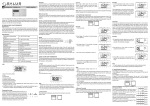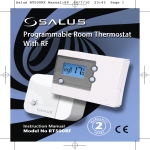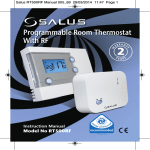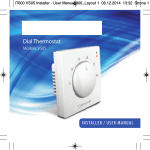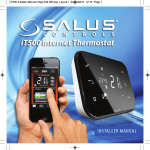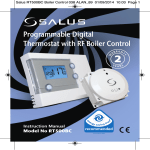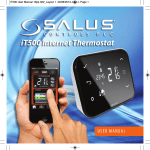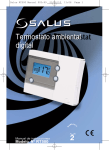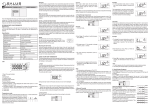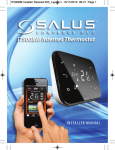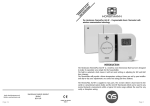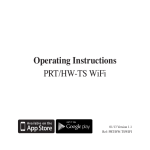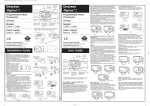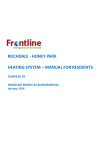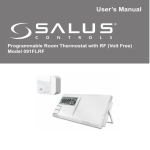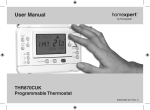Download File
Transcript
Salus RT300RF Manual 003_89 28/03/2014 11:50 Page 1 Digital Electronic Thermostat With RF Instruction Manual Model No RT300RF Salus RT300RF Manual 003_89 28/03/2014 11:50 Page 2 PRODUCT COMPLIANCE This product complies with the essential requirements of the following EC Directives: • Electro-Magnetic Compatibility directive 2004/108/EC • Low Voltage Directive 2006/95/EEC • EC Marking directive 93/68/EEC SAFETY INFORMATION These instructions are applicable to the SALUS Controls model stated on the front cover of this manual only, and must not be used with any other make or model. These instructions are intended to apply in the United Kingdom only, and should be followed along with any other statutory obligations. This accessory must be fitted by a Competent person, and installation must comply with the guidance provided in the current editions of BS7671 (IEE Wiring Regulations) and Part ‘P’ of the Building Regulations. Failure to comply with the requirements of these publications could lead to prosecution. Always isolate the AC Mains supply before opening or removing the unit from the wall or wall box. When fitting batteries don’t mix old and new batteries together. Do not use rechargable batteries. Please leave these instructions with the end user where they should be kept in a safe place for future reference. 2 RT300RF INSTRUCTION MANUAL Salus RT300RF Manual 003_89 28/03/2014 11:50 Page 3 What is a room thermostat? ... an explanation for householders A room thermostat simply switches the heating system on and off as necessary. It works by sensing the air temperature, switching on the heating when the air temperature falls below the thermostat setting, and switching it off once this set temperature has been reached. Turning a room thermostat to a higher setting will not make the room heat up any faster. How quickly the room heats up depends on the design of the heating system, for example, the size of boiler and radiators. Neither does the setting affect how quickly the room cools down. Turning a room thermostat to a lower setting will result in the room being controlled at a lower temperature, and saves energy. The heating system will not work if a time switch or programmer has switched it off. The way to set and use your room thermostat is to find the lowest temperature setting that you are comfortable with, and then leave it alone to do its job. The best way to do this is to set the room thermostat to a low temperature – say 18°C – and then turn it up by one degree each day until you are comfortable with the temperature. You won’t have to adjust the thermostat further. Any adjustment above this setting will waste energy and cost you more money. If your heating system is a boiler with radiators, there will usually be only one room thermostat to control the whole house. But you can have different temperatures in individual rooms by installing thermostatic radiator valves (TRVs) on individual radiators. If you don’t have TRVs, you should choose a temperature that is reasonable for the whole house. If you do have TRVs, you can choose a slightly higher setting to make sure that even the coldest room is comfortable, then prevent any overheating in other rooms by adjusting the TRVs. Room thermostats need a free flow of air to sense the temperature, so they must not be covered by curtains or blocked by furniture. Nearby electric fires, televisions, wall or table lamps may prevent the thermostat from working properly. RT300RF INSTRUCTION MANUAL 3 Salus RT300RF Manual 003_89 28/03/2014 11:50 Page 4 INTRODUCTION The RT300RF from SALUS Controls is a stylish and accurate digital thermostat with a large, easy to read Liquid Crystal Display (LCD). This thermostat has been specifically designed to be used for both Volt Free and AC heating applications, can replace most common residential thermostats and is designed to be used with electric, gas or oil heating control systems. Unlike ordinary single unit design thermostats, this is a new type of thermostat separating the operational functions into two units. The Receiver is used for wiring connections and heat on/off control. The Control Centre provides the user interface and temperature sensing / control. The two units are linked together by a Radio Frequency (RF) signal. Features • • • • • Volt free switching option Frost protection Large, easy to read LCD with blue backlight Burner on symbol User friendly 4 RT300RF INSTRUCTION MANUAL Salus RT300RF Manual 003_89 28/03/2014 11:50 Page 5 INSTALLATION Please read the important safety information at the start of this manual before you begin to install the device. The RT300RF Control Centre is easily installed using the Industry Standard back plate supplied with the unit – this is used purely for mounting purposes, as no wiring is needed for the Control Centre. The back plate can be mounted directly to the wall surface. The ideal position to locate the RT300RF Control Centre is about 1.5m above floor level. It should be mounted in a location where the thermostat is accessible, reasonably lit and free from extremes of temperature and draughts. Do not mount the thermostat on an outside wall, above a radiator or in a location where it may be subjected to direct sunlight. To ensure trouble free operation of the Radio Frequency (RF) signal, always ensure that the programmable thermostat is mounted away from any possible sources of interference (such as radios, TV sets, computers, etc.), and is not mounted on or in close proximity to large metal objects. Installing the RT300RF in enclosed areas such as cellars and basements is not recommended. CONNECTING THE RT300RF RECEIVER NOTE: All electrical installation work should be carried out by a suitably qualified Electrician or other competent person. If you are not sure how to install this digital thermostat consult either with a qualified electrician, heating engineer or your boiler / heating system supplier for advice on how to continue. RT300RF INSTRUCTION MANUAL 5 Salus RT300RF Manual 003_89 28/03/2014 11:50 Page 6 The RT300RF Receiver should be mounted in a suitable location that is both accessible for the connection of mains and control wiring, and allows good reception of the RF signal. The Receiver needs a 230V AC mains supply to operate, and this should be fused appropriately (13A max.). The Receiver should be mounted in a location where it will not come into contact with water, moisture or condensation. The Receiver On/Off switch is accessible from the front face of the Receiver, as shown in this picture: On the front cover of the Receiver you will see that there is the On/Off switch and two Light Emitting diodes (LEDs). The switch allows you to turn off the Receiver if necessary to prevent it calling for heat. The bottom LED (red) will illuminate when the switch is in the ‘On’ position and the unit is receiving power. The top LED (green) illuminates when the Receiver unit is receiving a heat call transmission from the Control Centre. The wiring terminals and RF Address Code setting DIP switches are located on the rear of the Receiver, as shown in this picture: 6 RT300RF INSTRUCTION MANUAL Salus RT300RF Manual 003_89 28/03/2014 11:50 Page 7 RECEIVER WIRING TERMINALS Terminal Identifier Description 1 NO 2 COM Normally Open [N/O] Linked Live feed (230V AC heating applications only) 3 L Live feed (230V AC) 4 N Neutral TYPICAL WIRING INSTALLATIONS a.230V AC Installation Notes: • Receiver unit should have a permanent 230V AC main supply • Confirm that the Boiler has an external thermostat loop and is configured for 230V switching • If the boiler has two terminals for the thermostat, remove the link from the boiler RT300RF INSTRUCTION MANUAL 7 Salus RT300RF Manual 003_89 28/03/2014 11:50 Page 8 b. 24V Installation Notes: • Receiver unit should have a permanent 230V AC main supply • Confirm that the Boiler has an external thermostat loop and is NOT configured for 230V switching • If the boiler has two terminals for the thermostat, remove the link from the boiler 8 RT300RF INSTRUCTION MANUAL Salus RT300RF Manual 003_89 28/03/2014 11:50 Page 9 CONTROL CENTRE JUMPER SETTINGS Changes to the jumper settings should only be made by the Engineer carrying out the installation or other qualified person. The installer should select the jumper positions required if changes need to be made to the factory default settings. These jumpers are found on the rear of the Control Centre. Jumper Function Span Movable jumper for selecting temperature span of ± 0.5°C (factory default setting) or ± 1.0°C 1,2,3,4,5 Removable jumpers for altering the RF address code when used in conjunction with the corresponding DIP switch on the Receiver. NOTE: The Reset button must be pressed after changing jumper positions. The Reset button is accessible behind the small hinged door on the front right hand side of the Control Centre. RT300RF INSTRUCTION MANUAL 9 Salus RT300RF Manual 003_89 28/03/2014 11:50 Page 10 RF ADDRESS CODE SETTING If there is another unit being used nearby, e.g. in the next house or as part of a multiple installation, your Receiver may be fault triggered by the other Control Unit. You can change the RF Address Code to help prevent this problem. Each Receiver can only respond to RF transmissions from a Control Centre that has the same RF address code setting. Disconnect any AC power to the Receiver, and remove the batteries from the Control Centre before attempting any adjustment of the RF Address Code switches and jumpers. If you are not sure how to carry out this operation correctly, consult either with a qualified electrician or heating engineer. To adjust the RF address code of the Receiver, simply push up one or more of the 5 DIP switch levers on the DIP switch bank located on the back of the receiver (the levers are numbered 1 to 5 from bottom to top, as shown in the picture below), and then make a note of the setting of each switch: 10 RT300RF INSTRUCTION MANUAL Salus RT300RF Manual 003_89 28/03/2014 11:50 Page 11 To adjust the RF address code of the Control Centre, remove one or more of the jumper caps located on the back of the unit (labelled 1,2,3,4 and 5, and shown in the picture below) so that the jumper settings match the settings made on the receiver: For example, if the DIP switches on the Receiver were set as follows: 1 2 3 4 5 - ON OFF OFF OFF ON Then you would need to remove jumper caps 2,3 and 4 on the Control Centre to make sure that they are both set with the same RF address code. Please make sure that you keep any of the jumper caps you remove in a safe place, in case you later need to change the RF address setting again. You must press RESET on the Control Centre after making any changes to the RF address code settings. RT300RF INSTRUCTION MANUAL 11 Salus RT300RF Manual 003_89 28/03/2014 11:50 Page 12 TESTING THE RF TRANSMISSION It is important to site both the Receiver and Control Centre in locations where the RF signal cannot be interrupted. The receiving range between Control Centre and Receiver is approximately 30 metres indoors, however many factors can affect the RF transmission and shorten the operating distance, e.g. shielding by thick walls, foil back plasterboard, metal objects such as filing cabinets, general RF interference, and so on. The range is generally large enough for most household applications, but it is advisable to test the RF transmission from the intended Control Centre location to the Receiver location before fixing the Control Centre to the wall. To check the RF reception, follow the following steps: 1. Press the UP button on the Control Centre until the set point temperature is higher than room temperature by a few degrees. 2. Wait for a few seconds. The Burner on (heat call) indicator should appear on the bottom left of the LCD on the Control Centre. 3. Check the green LED on the receiver unit - it should be lit. 4. Press the DOWN button to adjust the set point temperature to be lower than room temperature. 5. Wait for a few seconds, and the Burner on (heat call) indicator should disappear and the green LED should switch off. 6. If at step 3 the green LED is not illuminated, press the RESET button on the Control centre and try to place the Control Centre closer to the Receiver. 7. Repeat steps 1 to 5. If you are unable to get a stable RF connection between the Receiver and Control Centre, check that the Receiver is both switched on and has a mains supply (red LED lit). If this isn’t the problem you can also alter the RF address code by following the ‘RF Address Code Setting’ section of this manual, and then repeat steps 1 to 5 (note that the RESET button on the Control Centre should be pressed after altering the address code). 12 RT300RF INSTRUCTION MANUAL Salus RT300RF Manual 003_89 28/03/2014 11:50 Page 13 MULTIPLE THERMOSTAT INSTALLATIONS If you are using more than one RT300RF digital thermostat in the same installation, be sure that there is at least a 1 metre gap between receiver units to avoid crosstalk and other RF interference. When installing multiple thermostats, you should assign different RF address codes for each RT300RF by following the instructions in the ‘RF Address Code Setting’ section of this manual. Each RT300RF should be introduced to the installation one at a time with all other Receiver units switched off. Also make sure that the batteries are removed from all other Control Centres. Install each unit following the ‘Testing the RF Transmission’ section above once you are happy with the operation of one unit you can install the next. Once all the RT300RF units have been installed, if one unit then seems to function abnormally, try changing the RF address code of that unit’s Control Centre and its corresponding Receiver, making sure that the new RF address code is different to all others in the installation. The control centre sends RF On/Off signals every 10 minutes to ensure the Receiver is in the correct state. If for some reason the first RF signal is interrupted you may notice the Control Centre has stopped or started calling for heat but the Receiver hasn’t switched. Simply wait 10 minutes until the next RF signal is transmitted and the receiver unit should then switch correctly. RT300RF INSTRUCTION MANUAL 13 Salus RT300RF Manual 003_89 28/03/2014 11:50 Page 14 AFTER INSTALLATION The following table shows the settings of the RT300RF digital thermostat after Power on, or after RESET is pressed: Function Status After Reset or Power On Operation Mode Normal mode Room Temperature 22.0 °C, updated within 5 seconds Set Point Temperature 20.0 °C Frost Protection indicator Off Heat indicator Off Low-Battery Warning indicator Off, updated within 5 seconds Output Relay Off After Power on, the thermostat will operate in Normal mode (Normal mode is when the thermostat is displaying the room temperature): • • • The set point temperature is reset to the default setting The room temperature display is updated within 5 seconds The control process starts 14 RT300RF INSTRUCTION MANUAL Salus RT300RF Manual 003_89 28/03/2014 11:50 Page 15 USER INTERFACE AND CONTROLS The status and operation of the RT300RF is clearly shown on the large backlit Liquid Crystal Display (LCD). This display allows the user a clear indication of the current room temperature, and the status of the heating system. There are few user controls for the RT300RF, making this thermostat very easy to operate. These controls are shown below, along with a description of each of their functions. USER CONTROL FUNCTION SUMMARY Key / Operation Symbol Functions UP key Increases the selected setting DOWN key Decreases the selected setting BACKLIGHT / Manually turns on the LCD backlight FROST key for 5 seconds, or activates / deactivates Frost Protection RESET button Resets the programmable thermostat to default (original factory) settings RT300RF INSTRUCTION MANUAL 15 Salus RT300RF Manual 003_89 28/03/2014 11:50 Page 16 OPERATION The RT300RF is configured and adjusted by the use of a minimal number of user controls, and an intuitive user interface. The backlit Liquid Crystal Display (LCD) gives a highly visible, easily readable indication of the programmable thermostat status. REVIEWING SET POINT TEMPERATURE You can view the set point temperature at any time by pressing either the UP or DOWN key. To exit from the set point review, press the BACKLIGHT / FROST key, or don’t press any keys for approximately four seconds – either of these actions will return the RT300RF to displaying current room temperature. SETTING SET POINT TEMPERATURE You can change the set point temperature very easily while you are reviewing the set point temperature. Press the UP or DOWN keys repeatedly to change the temperature setting. The set point temperature will flash to indicate that it can be changed: The temperature will be changed in 0.5°C steps per key press. The RT300RF will return to Normal mode if no keys are pressed for more than four seconds. Set point temperature cannot be changed if Frost Protection mode is enabled. 16 RT300RF INSTRUCTION MANUAL Salus RT300RF Manual 003_89 28/03/2014 11:50 Page 17 FROST PROTECTION To enable the Frost Protection mode, press and hold the BACKLIGHT / FROST button for three seconds. Once Frost Protection is enabled, the set point temperature is automatically set to 5°C to provide protection from the risk of freezing. Whenever Frost Protection is activated, the Frost Protection indicator will flash in the sequence shown below: To turn off Frost Protection mode, press and hold the BACKLIGHT / FROST button for three seconds. Please be aware that the Frost Protection mode operates as an additional protection feature but should not be used in place of a correctly installed frost thermostat, which is required to override all other controls in the system. The backlight will remain illuminated for approximately 5 seconds. RT300RF INSTRUCTION MANUAL 17 Salus RT300RF Manual 003_89 28/03/2014 11:50 Page 18 OTHER FUNCTIONS AND CONTROLS Backlight The backlight of the RT300RF is switched on automatically whenever any of the keys are pressed. The backlight will remain illuminated for approximately 5 seconds after the last key press, except if you are changing the set point temperature – in this case, the backlight will remain illuminated throughout the setting change process. The backlight will not illuminate if the RT300RF battery is low. Battery Status The RT300RF checks the battery voltage frequently during normal operation. If the battery voltage is sensed as being low (this is normally when the battery voltage falls to a level of around 2.6V), the low battery indicator will be displayed on the screen. Although the programmable thermostat will continue to operate normally at this stage, you should replace the batteries as soon as possible to prevent any possible operating problems. Reset Button The Reset Button is provided as a way to restore the thermostat to its default factory settings. Pressing this button will delete any previously entered settings. Sleep Mode By pressing both the UP and DOWN keys together, the RT300RF will enter SLEEP mode. In this mode, all the RT300RF functions will be paused to save battery power. While in SLEEP mode: • The LCD display will be blank. • All output from the Control Unit will be turned off immediately. Press any key to wake up the RT300RF and cancel SLEEP mode. 18 RT300RF INSTRUCTION MANUAL Salus RT300RF Manual 003_89 28/03/2014 11:50 Page 19 TEMPERATURES OUTSIDE THE OPERATING RANGE Temperatures below 10 °C are displayed without the leading ‘0’. Temperatures exceeding the measurable range will be indicated by ‘HI’ for temperatures above the upper limit, and ‘LO’ for temperatures below the lower limit, as shown in the images below: ENERGY TIP One way to set and use your room thermostat is to find the lowest temperature setting that you are comfortable with, and then leave it set at this temperature. You can do this by setting the room thermostat to a low temperature, (for example 17 °C) and then increasing the setting by one degree each day until you are comfortable with the room temperature you won’t have to adjust the thermostat further, as adjustment above this setting will waste energy - a 1 °C increase in temperature is equal to 3% of your heating costs. RT300RF INSTRUCTION MANUAL 19 Salus RT300RF Manual 003_89 28/03/2014 11:50 Page 20 MAINTENANCE The RT300RF electronic thermostat requires no special maintenance. Periodically, the outer casing can be wiped clean using a dry cloth (please DO NOT use solvents, polishes, detergents or abrasive cleaners, as these can damage the thermostat). There are no user serviceable parts within the unit; any servicing or repairs should only be carried out by SALUS Controls or their appointed agents. Should the RT300RF electronic thermostat fail to function correctly, check: • The batteries are the correct type, fitted correctly and are not exhausted - fit new batteries if in doubt. • Heating system is switched on. • The RT300RF Receiver is switched on. • If the RT300RF is still not functioning correctly, press the Reset Button. WARRANTY SALUS Controls warrants that this product will be free from any defect in materials or workmanship, and shall perform in accordance with its specification, for a period of two years from the date of purchase. SALUS Controls sole liability for breach of this warranty will be (at its option) to repair or replace the defective product. 20 RT300RF INSTRUCTION MANUAL Salus RT300RF Manual 003_89 28/03/2014 11:50 Page 21 PRODUCT SPECIFICATION Model: Type: Frequency Temperature Scale: Range: Resolution: Tolerance: Display Range: Display Resolution: Frost Protection Setting: Setpoint Temperature Range: Control Centre Power Source: Receiver Power Source: Switch Rating Switching Voltage: Switching Current: Protection Rating: Environment Operating Temperature: Storage Temperature: RT300RF Digital thermostat, designed for Volt Free and AC heating applications. 868 MHz Celsius 5 ºC to 35 ºC 0.5 ºC Less than ± 0.5 ºC at 25 ºC 5.0 ºC to 45.0 ºC 0.5 ºC 5 ºC 5 ºC to 35 ºC 2 x AA alkaline batteries (don’t use rechargeable batteries) 230V AC / 50Hz 0 - 230V AC / 50Hz 16A resistive, 5A inductive IP30 0 ºC to + 40 ºC - 10 ºC to + 60 ºC RT300RF INSTRUCTION MANUAL 21 Salus RT300RF Manual 003_89 28/03/2014 11:50 Page 22 RT300RF Warranty SALUS Controls warrants that this product will be free from any defect in materials or workmanship, and shall perform in accordance with its specification, for a period of two years from the date of purchase. SALUS Controls sole liability for breach of this warranty will be (at its option) to repair or replace the defective product. Customer Name: .................................................... Customer Address: ................................................ ............................................................................... Post Code: ..................... Tel No: ............................ Email: ..................................................................... Engineers Company: .............................................. Tel No: ................................................................... Email: .................................................................... Intallation Date: ..................................................... Engineers Name: .................................................... Engineers Signature: .............................................. 22 RT300RF INSTRUCTION MANUAL Salus RT300RF Manual 003_89 28/03/2014 11:50 Page 23 RT300RF INSTRUCTION MANUAL 23 Salus RT300RF Manual 003_89 28/03/2014 11:50 Page 24 salus-tech. Sales: Email: [email protected] Tel: 01226 323961 Technical: Email: [email protected] Tel: 01226 323961 SALUS Controls plc, SALUS House, Dodworth Business Park South, Whinby Road, Dodworth, Barnsley S75 3SP Ver 002 28/3/14

























